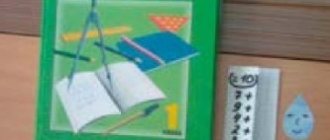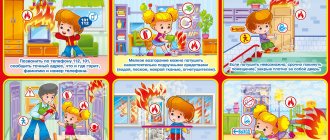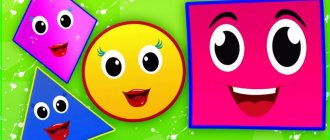Technological map - construct
| Reflection 2-3 min. | Summing up, positive assessment of the result obtained | Expresses sincere admiration. Thanks the children, receives positive feedback from the forest inhabitants. Provides opportunities for independent play. | Children are happy with the results obtained and the positive assessment of their work. They are glad that they were able to help. Participate in play activities. | The children are satisfied with the results of their activities. Express positive emotions. |
Synopsis of the educational activity “In a forest clearing”.
Educational areas:
“Cognitive development”, “Social and communicative development”, “Speech development”, “Artistic and aesthetic development”, “Physical development”.
Kind of activity:
gaming, communicative, motor.
Age group:
younger age.
Temporary resource:
15 minutes.
GCD topic:
"In a forest clearing."
Target:
formation of elementary mathematical concepts; to train children in using mathematical knowledge in a play situation; consolidate children's mathematical concepts through didactic games.
Tasks:
Educational:
— consolidate children’s knowledge about elementary sensory standards (shape, color, size);
- consolidate mathematical concepts: one-many, the same amount (equally), more-less, high-low, big-small;
- to consolidate children’s knowledge about wild animals and the rules of behavior in the forest;
-improve the ability to distinguish and name geometric shapes (circle, square, triangle, rectangle).
Educational:
—
develop attention, memory, communication skills;
-develop the ability to make proposals and draw simple conclusions, to express one’s thoughts clearly for others.
Educational:
- cultivate a sense of compassion and desire to help;
-develop communication skills with adults and peers;
- cultivate love and interest in living nature.
Facilities:
- visual:
bell;
-musical:
musical recordings of forest noise, birdsong;
-materials, equipment:
easel (magnetic board), CD player, set of large geometric shapes, images of hedgehogs and Christmas trees (3 pieces, different in size), a set of numbers from 1 to 5, educational games “Butterflies and Flowers”, “Hide the Mouse”.
Planned result:
they can recognize and name elementary sensory standards (color, shape, size), they can compare using the application method, they can arrange objects by height and size (up to 3 objects) and name them accordingly, they can count to 5 or more.
Attitude to activity:
interest, emotionality, children willingly engage in playful interactions with adults and peers.
Preliminary work:
acquaintance with sensory standards (color, shape, size), viewing pictures of the forest at different times of the year, conversations about the rules of behavior in the forest, about forest inhabitants, didactic games “Moms and their children”, “What color”, “Pick a pair”, “What is round (square, triangular”, “Correspondences”, designing, drawing and applique “House”, listening to musical pieces on the theme “Forest”.
GCD construct “Travel with the Hedgehog to the Magic Forest”
author: Kryukova Olga Vladimirovna
Teacher at the Children's Educational Institution "Kindergarten No. 15" in Krasnoturinsk
GCD construct “Travel with the Hedgehog to the Magic Forest”
Municipal autonomous preschool educational institution "Kindergarten No. 15"
Construct of continuous educational activities
with children of the fourth year of life
(educational areas “Cognitive development”, “Speech development”)
"Travel with the Hedgehog to the Magic Forest"
Educator: Olga Vladimirovna Kryukova
GO Krasnoturinsk
2019
Subject
: “A trip with the Hedgehog to the magical forest.”
Age group:
children of the fourth year of life.
GCD form:
cognitive-research, communicative.
Form of organization
(group).
Educational and methodological kit
: Babaeva T.I., Gogoberidze A.G., Solntseva O.V. Childhood: Sample educational program for preschool education.
Facilities:
Gaming
toy Hedgehog, playing field “Mini-Large”, set “Multi-colored ropes”, “Multi-colored gnomes”, logic blocks of Dienesh, planar geometric shapes.
Visual
a picture depicting the articulation exercise “Smile”, symbol cards with block properties.
Literary
riddle about a hedgehog.
Equipment:
rubber mats, rope.
Target:
the formation of cognitive motivation and the formation of cognitive actions, maintaining the child’s initiative and independence in verbal communication with adults and peers.
| Objectives of the educational program |
| Educational: — develop the articulatory apparatus, consolidate the correct pronunciation of the isolated sound [f]; - develop the ability to group geometric shapes by color, size and shape; Educational: - learn to understand the questions posed by the teacher and answer them at the request of an adult; - learn to select definition words for the word “hedgehog”; Educational: — Developing communication skills, interaction, and a sense of goodwill. |
| Stages (sequence) of activity | Contents of activities (methods and techniques) | Actions, activities of the teacher | Actions, activities of children, implementation, which will lead to the achievement of planned results | Planned result |
| Motivation for joint activities | - Guys, today a guest came to us from a magical forest, and who is it? Guess the riddle: Fur coat - needles. It will curl up - prickly. You can't take it with your hand. Who is this? (Hedgehog) - That's right, it's a hedgehog. Let's say hello and smile to him. Articulation exercise “Smile”. | Creates an atmosphere of interest. Makes a riddle. Shows a picture of the “Smile” exercise being performed. | Children guess the riddle. Perform an articulation exercise (in chorus and individually) | Readiness of children to communicate with adults in joint activities |
| Updating knowledge | - What hedgehog? (Prickly, gray, small, hardworking) - What is the hedgehog doing? (Gets food, hunts mice) — Now let’s play the game “What does a hedgehog look like”: Prickly hedgehog, what? (like a Christmas tree) Gray hedgehog, like who? (like a bunny, like a kitten) — Hedgehog: Right. Let's sing the hedgehogs' song. Song of an adult hedgehog: “F-F-F” small hedgehog | Asks questions that stimulate the thinking process. Plays a word game. Reminds me of a hedgehog song. | Children answer questions. Children make guesses. Children pronounce the sound [f] louder, quieter. | Shows curiosity. Shows interest in communicative activities. |
| Motivation for activity Game situation | — Hedgehog: I invite you guys to the magical forest to see my friends. — Educator: How do we get there? — Hedgehog: You need to say the magic words: “Wa-wa-wa, grass has grown in the forest.” — Hedgehog: The road to the magic forest is not easy, I will help you. You need to go over the bumps and jump over the stream. Here we are. The magical gnomes “Kohle” and “Jelly” live here. Dwarves love to play, let's play. | Emotionally involves children in action. Pronounces pure speech. Draws attention to the carpet. | Children take turns pronouncing the phrase (in chorus, individually) They are walking along a magical road. | Showing initiative in communicating with adults |
| Physical school | We are funny gnomes In our home, we sing songs! (hands on the belt, bending to the sides) We love to run like mice. (running in place) We are funny gnomes In our home, we sing songs! (alternately put out the right and left legs) We love to stomp like elephants. (stomp on the spot) We are funny gnomes In our home, we sing songs! (spinning) We love to jump like bunnies! (jumping in place) | Emotionally involves children in action. | Motor activity of children. | The desire for physical activity. |
| Updating children's knowledge | — Hedgehog: I prepared gifts for the gnomes, but a mischievous wind blew and mixed up all the gifts. Guys, can you help me sort out the gifts? (There are blocks and symbol cards on the table) — On the table in front of you are 2 cards, pieces of paper with hoops drawn on them. You and I will, in accordance with the card symbol, distribute the blocks into hoops. For example, on a card there is a geometric figure drawn, a square and the color red, which means that all the red squares must be placed in this hoop. On another card there is a circle drawn and the color is yellow, which means that all yellow circles must be placed in this hoop. — Yesenia and Nikita will lay out the figures on the carpet. Other children lay them out on the tables. — Why are these particular blocks in this hoop? — Hedgehog: Thank you guys for helping me. — Educator: It's time for us to go back to kindergarten. Goodbye hedgehog! We are walking along the magic path. | Creates an atmosphere of interest. Organizes children. Draws attention to the carpet. Explains. Observes children while performing tasks. | Emotionally involved in the action. The children sit at the tables. The children are listening. (Individual work : two children perform a task on a carpet machine). Children sort by shape, color, size. Children return to kindergarten along a magical path. | Showing initiative in communicating with adults. Demonstrates the ability to generalize a group of objects by properties. |
| 3. Final part. Reflection Motivation for further knowledge | - Guys, please tell me where we went today? — What did you like most? —Who were you able to help? - Guys, do you want to know who else lives in the magical forest? | Asks questions that stimulate generalization of the results of children's activities. Initiates the children's mood for new knowledge. | Children convey their impressions about the process and results of joint activities. | Demonstrate the ability to analyze their activities. |
GCD construct “Travel with the Hedgehog to the Magic Forest”
FORM AND STRUCTURE OF WRITING A LESSON PLAN FOR A PRESENTERHOUSE IN ACCORDANCE WITH THE GEF
FORM AND STRUCTURE OF WRITING A LESSON PLAN FOR A PRESENTERHOUSE IN ACCORDANCE WITH THE GEF
With the introduction of the Federal State Educational Standard for preschool education, the approach to organizing and conducting direct educational activities with children has changed.
Along with traditional classes, built in the logic of the educational model, classes are conducted in the form of exciting joint activities, during which the teacher solves program problems. The role of the teacher is being rethought, becoming somewhere an “assistant”, and somewhere a “coordinator” or “mentor”, and somewhere a direct source of information.
The position of a preschool teacher in relation to children changes and takes on the nature of cooperation when the child acts as an equal partner in a situation of joint activity and communication with the teacher.
New approaches to organizing and conducting classes with children naturally entail changes in the design of teaching materials accompanying the educational process, namely notes.
Most teachers do not attach importance to this, continuing to write notes in the form of long texts, which mainly describe the activities of the teacher (“the teacher tells”, “the teacher offers”, etc.). This outdated form of notes does not give a complete and holistic picture of the joint activities of adults and children in the classroom:
In the notes, teachers place poems, riddles, games and other materials that increase the volume of the notes many times over and make it difficult to perceive and understand the essence (core) of the event itself. It would be much more expedient to arrange these materials in the form of an appendix to the outline.
In this regard, there is an urgent need to come to a common understanding of the logic of taking notes. It is important to develop a unified form that would not only be informative, i.e. would give an accurate idea of the content of the activity of both the teacher and the children in the lesson, but even at the stage of drawing up notes, it would help the teacher navigate the key points of the pedagogical event for its competent construction.
Abstract structure
Target
What is a goal? The goal is the end result, what we strive for. The goal is achieved through tasks, which in relation to the goal are means, i.e. The step-by-step solution of the assigned tasks leads to the achievement of the goal. It is recommended that the goal be determined by a noun from a verb: creating conditions, forming, educating, strengthening, etc.
How to correctly prepare a GCD outline in accordance with the Federal State Educational Standard
Tatiana Pylnova
How to correctly prepare a GCD outline in accordance with the Federal State Educational Standard
Methodological recommendation for educators
How to properly prepare a GCD outline
in accordance with the Federal State Educational Standard
Some teachers have difficulty preparing GCD notes. I suggest you remember how this is done. We'll start with the title page.
The full name of the preschool organization is indicated at the top of the title page. In the middle of the sheet is written the topic of the summary, educational area, age group. Below the title of the abstract, on the right, the surname and initials of the author, his position, and group number are indicated. At the bottom of the title page, in the middle, the city is written, and even lower is the year when the summary was written.
The next sheet begins with the gcd goal. What is a goal? The goal is the end result, what we strive for. It is recommended to define the goal as a noun from a verb: creating conditions, forming, educating, strengthening, etc. Tasks should be formulated with a verb in an indefinite form: creating, strengthening, educating, implementing, etc.
A task is something that requires execution or solution. Tasks in relation to the goal are:
Educational
(it is written what we will teach children in this lesson). Remember not to write the verb “teach”. Write more competently - promote, develop skills, create conditions, develop, etc.
Developmental
(it is written that we will consolidate, clarify, not forgetting the development of mental functions and various properties).
Educating
(what mental, aesthetic, moral and volitional qualities will be formed in this lesson).
Remember that each new task is written on a new line.
After the tasks, we write down what kind of preliminary work with the children (conversations, observations, reading fiction, where we went on an excursion, what we learned, etc.).



